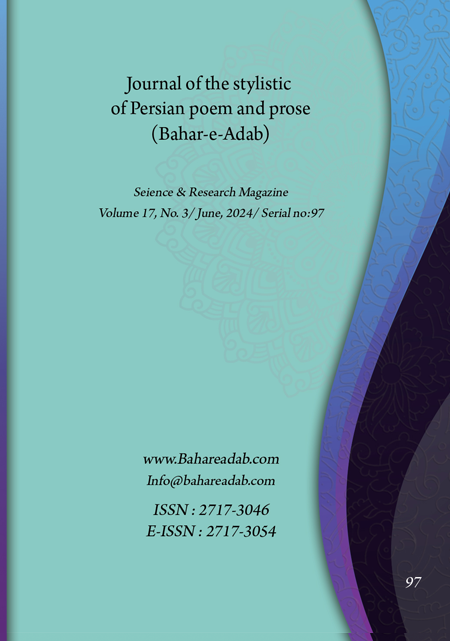- Count View : 222
- آدرس کوتاه شده مقاله: https://bahareadab.com/article_id/1640
- کد doi مقاله: Doi: 10.22034/bahareadab.2024 .17 .7379
Journal of the stylistic of Persian poem and prose
volume Number 17،
number In Volume 3،
،
issue Number 97
Ancient, ritual and religious myths in the poetry of poets of the Islamic revolution and sustainable literature (Case study: review of the poems of Qaiser Aminpour, Nasrullah Mardani, Seyyed Hasan Hosseini and Salman Herati)
Gholamreza Hassani , Majidreza Khazaei Vafa (Author in Charge), Ali Mandegar
Abstract
BACKGROUND AND OBJECTIVES: The war imposed by Iraq against Iran is one of the influential events and incidents in the political history of contemporary Iran, which affected various aspects of the individual and social life of the Iranian people, including artists, poets and writers. Literature, especially Persian poetry, as one of the areas that reflect human thoughts and ideas, has depicted these changes and transformations. With the beginning of the war imposed by Iraq against Iran, the poets of the field of literature of stability and sacred defense tried to use the help of various religious and national myths in the poetry of this field, the lost identity and ancient values in order to strengthen the national, patriotic and spiritual spirit of the Iranian nation. Warriors revive. The purpose of the upcoming research is to investigate national, ritual and religious myths in the poetry of the poets of the holy defense and the literature of sustainability.
METHODOLOGY: This research is a descriptive-analytical approach based on library studies and the sand analysis method, which, using the knowledge of mythology, tries to explain the elements of national and religious myths in the poems of Qaisar Aminpour, Seyed Hassan Hosseini, Nasrullah Mardani and Salman Herati.
FINDINGS: The findings of this research indicate that the poets of Persian language and literature in various fields and fields, including sustainable literature, have still maintained their intellectual connection with the mysterious and sacred sources of ancient Iranian and religious myths; The use of myth in the poetry of these poets is more aimed at stimulating and motivating the audience.
CONCLUSION: The results of this research, by examining the works, show that the aforementioned poets have paid more attention to the sacred role and function of religious legends, in order to thereby compare the bravery of martyrs, warriors, sacrificers and heroes of the battlefield in comparison to the heroes of religious legends, including Draw Imam Hussain (a.s.) In addition to using religious myths, national and ancient myths such as the myth of Ruyin Teni Esfandiar, Rostam, Passing Haft Khwan, Simorgh (Anqa) and Dhahhak have also been significantly used.
Keyword
literature of stability and sacred defense
, Religious and religious mythology
, Poetry
, Identification.
- Aminpour. Caesar (1387). That dear friend. (Memorandum of Nasrullah Mardani). Tehran: Hozeh Art Publications, p. 59.
- ............................ (1388). Complete collection of poems. second edition. Tehran: Marvarid Publications.
- Bahar. Mehrdad (1376). From the myth of history. Tehran: Cheshmeh, p. 346.
- Chadwick. Challenges (1375). Symbolism. Translation: Mehdi Sobhani. Tehran: Center, p. 91. 10.
- Edgar. Andrew and Sabah Vic. Peter (1388). Basic concepts of cultural theory. Translated by: Mohammad Benavi and Mehran Atvad. Tehran: Aghaz, p. 43.
- Eliade. Mircha (1362). Perspectives of myth. Translation: Jalal Sattari. Tehran: Tos: pp. 14-21
- ……………… (1374). Myth, dream, code. Translation: Jalal Sattari. Tehran: Tos, p. 72.
- Gurin. Wall (1370). A guide to literary criticism approaches. Translation: Zahra Mehenkhah. Tehran: Information, p. 180.
- Harati. Salman (1365). Martyrdom poetry. Tehran: Islamic Revolution Martyr Foundation.
- ……………… (1387). Complete collection of poems by Salman Herati. Third edition. Tehran: Young Shaer Office.
- Hoghughi. Muhammad (1377). A review of the history of modern Iranian literature and literature (1). Tehran: Qatre, pp. 450-451.
- Hosseini. Seyedhassan (1388). Consonant with Halq Ismail. Fifth Edition. Tehran: Surah Mehr.
- ……………………… (1391 A). Generic drug plan. The seventh edition. Tehran: Surah Mehr.
- ……………………... (1391 B). Sparrow and Gabriel. Ninth edition. Tehran: Afog Publishing House.
- Hosseinpour Alashti. Hussein and Ismaili. Murad (1388). Analysis of myths in Siavash Kasraei's poems. literary study Number 9. pp. 106-89.
- Joari Mohammad Hossein (1383). Myth in comparative literature, citing myth and literature. Tehran: Samit, p. 44.
- Kazazi. Mirjalaluddin (1380). in another way Tehran: Center, p. 73.
- Khaleghi Motlagh. Jalal (1372). The flowers of old sorrows. Tehran: Center, p. 275.
- Knight. Jean and Gerbran. Alan (1388). The culture of symbols. Translated by Sudaba Fadaeli. second edition. The fourth volume. Tehran: Jihoon Publishing, pp. 526. 136-160.
- Lak. Manouchehr (1384). National identity in the poem of holy defense. National Studies Quarterly. Year 6, No. 22, pp. 111-132.
- Mardani. Nasrullah (1360). Rise of Light Tehran: Islamic thought and art.
- ………………….. (1370). blood of soil Tehran: Keihan Institute Research Office.
- ………………….. (1388). The law of love. Tehran: Sadra.
- Rashidian. Behzad (1370). Mythological insight in contemporary poetry. Tehran: Gostareh, p. 18.
- Roton. Kenneth Knowles (1378). the myth Translation: Abulqasem Ismailpour. Tehran: Center, p. 74.
- Sangri. Mohammadreza (1389). Criticism and review of the literature of Holy Defence. Tehran: Palisan, 19 - p. 234.
- Sarkarati Bahman (1378). Hunted Shadows. Tehran: Drop, p. 213.
- Satari Jalal (1388). The world of mythology. second edition. Tehran: Center, p. 124.
- Scientist. Mohammad and colleagues (1401). The course of reflection of mythological-epic traditions and themes in contemporary poetry of Afghanistan from the constitutional period to 1380. Literary techniques. fourteenth year Number 3. Serial 40. pp. 38-19.
- Surabadi. Abu Bakr Atiq (1347). Tafsir Surabadi. Proofreader: Ali Akbar Saidi. Volume 2. Tehran: New Publishing House. P. 193.
- Yahaghi. Jafar (1375). The culture of mythology and historical references in Persian literature. second edition. Tehran: Ministry, pp. 250-254.

